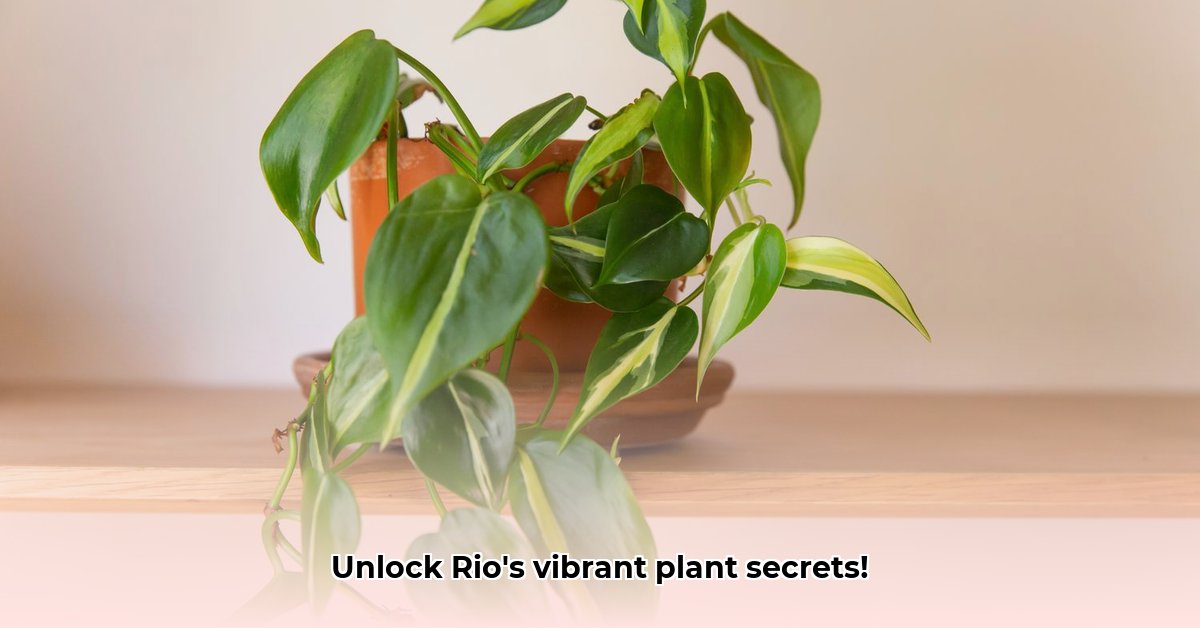Want a garden bursting with gorgeous, vibrant flowers? Rio Dipladenia (also called Mandevilla ‘Rio’) is your answer! This guide walks you through everything you need to know to grow these stunning vines, from planting to pest control and beyond, ensuring you enjoy beautiful blooms for years. Whether you’re a beginner or a seasoned gardener, we’ve got the tips and tricks to help you succeed. Let’s get growing! For more climbing vine options, check out this guide on ribbon plants.
Rio Plant Care: Your Guide to a Stunning, Blooming Vine
Let’s get your Rio plant thriving! These vigorous vines, with their vibrant blooms, are a genuine joy to grow, but a little know-how goes a long way. This guide walks you through choosing the perfect sunny spot and dealing with any little hiccups.
Understanding Rio Dipladenia: Varieties and Characteristics
Before diving into care, let’s explore the Rio Dipladenia’s charm. Originating from South America, particularly Brazil, this plant is celebrated for its trumpet-shaped flowers, which come in shades of red, pink, and white. Known also as Brazilian Jasmine, it offers a delicate fragrance, attracting pollinators to your garden.
Rio Dipladenias generally exhibit a bushy, vining growth habit, making them ideal for hanging baskets, pots, or training on trellises. Their glossy, deep-green leaves add to their visual appeal, providing a lush backdrop for the vibrant blooms.
Several popular varieties exist, including:
- Rio Red: Features classic, vibrant red flowers.
- Rio Pink: Showcases soft, delicate pink blooms.
- Rio White: Offers elegant, pure white flowers.
Each variety shares similar care requirements, making them a delightful and versatile addition to any garden.
Finding the Perfect Sunny Spot for Your Rio Plant: Light and Drainage
Sunlight is key whether you’re growing your rio plant indoors or outdoors! Your Rio plant needs at least four hours of direct sunlight each day to really shine, promoting healthy growth and abundant flowering. Think of a spot that gets the morning sun and perhaps a bit of afternoon shade, especially if you live somewhere really hot. This prevents scorching while still ensuring plenty of light for those gorgeous blooms.
Also, super important: make sure your chosen spot has excellent drainage. Soggy soil is a definite no-no for these beauties – it can lead to root rot and other problems. If your soil is heavy clay, consider amending it with some compost to improve drainage before planting, ensuring a well-aerated environment for the roots to flourish.
Preparing the Soil and Planting Your Rio Vine: Root System
Before you even think about planting, prep your soil. Remember, well-drained soil is essential for a healthy root system. Dig a hole twice as wide as the root ball. Mix the excavated soil with compost and a handful of slow-release fertilizer. Gently loosen the roots of your Rio Dipladenia before placing it in the hole. Backfill with the amended soil, ensuring the top of the root ball is level with the ground. After planting, give it a gentle watering, ensuring the soil is adequately moist. Don’t overdo it; aim for a moist, not soggy, soil.
The Art of Watering: Not Too Much, Not Too Little for Plant Hydration
Overwatering is a common mistake, so let’s get this right. Before watering, check the soil. Stick your finger about an inch into the soil – if it feels dry, it’s time to water. But don’t let it get bone dry either. How often you’ll need to water depends on your climate and the season. Hot, dry weather means more frequent watering; cooler, wetter weather means less to avoid fungal diseases and promote vibrant plant health. During peak growing season, this may mean watering every other day. In cooler months, once a week may suffice. Always adjust based on your specific conditions.
Feeding Your Rio Plant for Bountiful Blooms: Nutrient-Rich Soil
To encourage abundant blooms, regular feeding is a good idea during the growing season. A balanced, slow-release fertilizer is a great option; it feeds the plant gradually. Alternatively, you can use a liquid fertilizer every couple of weeks – just always follow the instructions on the package. One thing to remember: less is often more when it comes to fertilizer, so be sure not to overdo it. Over-fertilizing can actually harm your plant, leading to burnt roots and foliage. Look for a fertilizer with a higher middle number (phosphorus) to promote blooming, like a 10-20-10 formula.
Providing Support for Climbing Success: Trellis or Stake
While not the most rampant climber, your Rio plant will appreciate some support as it grows. A trellis, an obelisk, or even a sturdy stake will do the trick. This helps guide its growth, keeps it looking neat, and makes for a more attractive display in your garden. As your plant grows, gently guide the stems along the support structure, training it to climb gracefully. Secure the stems loosely with plant ties or soft twine to avoid damaging them. For container plants, consider a decorative bamboo stake or small trellis that complements the pot.
Pruning and Deadheading: Encouraging Continuous Blooms
Regular pruning and deadheading are essential for maintaining shape and encouraging continuous blooms. Remove spent flowers regularly to prevent the plant from putting energy into seed production. In late winter or early spring, prune back the vines to encourage bushier growth. Use sharp, clean pruning shears to make clean cuts and prevent disease. Pruning also helps to improve air circulation and sunlight penetration, further promoting healthy growth.
Keeping Pests and Diseases at Bay: Plant Protection Strategies
Rio plants are generally pretty tough and resistant to pests and diseases, but stress – like underwatering or too little sun – can make them more vulnerable. Regularly check your plant for any signs of trouble, such as spider mites or aphids. If you spot any pests, promptly treat them with an insecticidal soap or neem oil, ensuring the health and longevity of your plant. Good air circulation around your plant also helps prevent fungal diseases. For spider mites, increase humidity around the plant by misting regularly. For fungal diseases, ensure good drainage and avoid overhead watering.
Overwintering Your Rio Plant in Cooler Climates
If you live in an area where temperatures drop below 45°F (7°C) in winter, your Rio plant will need some extra protection. You can either bring the plant indoors to a sunny, cool spot (ideally around 50-55°F, or 10-13°C) or protect it where it’s planted using a thick layer of mulch around the base. Proper overwintering is crucial for ensuring your plant returns strong and healthy in the spring. Reduce watering during the winter months, as the plant’s growth will slow down significantly. If bringing the plant indoors, acclimate it gradually to the indoor environment to minimize stress.
Propagation: Growing More Rio Plants from Cuttings
Want more Rio plants? Propagation is easy! Take a 4-6 inch stem cutting from a healthy stem, remove the lower leaves, and dip the cut end in rooting hormone (though many find this isn’t strictly necessary). Stick the cutting in some moist potting mix or even just a glass of water. Keep it warm, and in a few weeks, you’ll likely see roots developing – you’ll have a brand-new Rio plant! Provide indirect light and maintain consistent moisture. Once the roots are well-established, transplant the cutting into a larger pot with well-draining soil.
Troubleshooting Common Problems: A Quick Reference Guide
| Problem | Possible Cause(s) | Solution |
|---|---|---|
| Yellowing Leaves | Overwatering, nutrient deficiency, root rot | Adjust watering; fertilize; check for root problems. |
| Poor Blooming | Insufficient sunlight, nutrient deficiency | Increase sunlight; fertilize or amend soil. |
| Pest Infestation | Stress, poor air circulation | Treat with insecticidal soap or neem oil. |
| Wilting | Underwater, extreme heat, root issues | Water thoroughly; provide shade if needed; check roots. |
| Leaf Spot | Fungal disease, poor air circulation | Improve air circulation; apply fungicide. |
| Stunted Growth | Poor soil, lack of nutrients, root bound | Repot; fertilize; amend soil. |
By following these tips, you’ll be well on your way to enjoying the beauty of your own thriving Rio plant by summer. Remember, attentive care is key. Happy gardening!
How to Overwinter Rio Dipladenia in Colder Climates: Strategies for Plant Survival
Key Takeaways:
- Rio Dipladenia, while stunning, isn’t cold-hardy. Protecting it from frost is crucial.
- Several successful overwintering methods exist, each with pros and cons to consider.
- Sustainable practices, such as using recycled pots and organic pest control, are key for plant well-being.
Understanding USDA Hardiness Zones: Choosing the Right Method
Rio Dipladenias thrive in USDA hardiness zones 9-11, where temperatures rarely drop below freezing. If you live outside these zones, overwintering is essential. Check your specific zone to determine the best strategy. Knowing your zone helps you gauge the level of protection your plant needs.
Choosing Your Overwintering Strategy: Cold Weather Plant Protection
First, you must decide how to overwinter rio dipladenia in colder climates to protect it from frost damage. Three main strategies are available:
- **
- Gray Kitchen Backsplash Tile: Ideas for a Stylish Upgrade - December 14, 2025
- Backsplash For Gray Cabinets: Choosing the Right Backsplash Style - December 13, 2025
- Gray And White Backsplash: Ideas For Timeless Style - December 12, 2025









